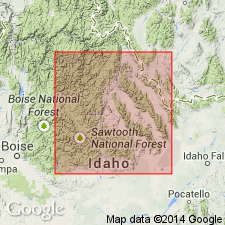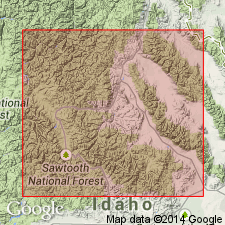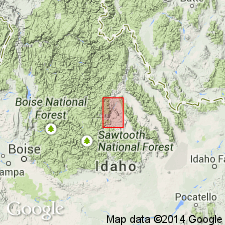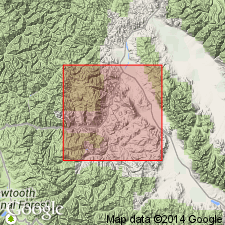
- Usage in publication:
-
- Bayhorse dolomite*
- Modifications:
-
- Principal reference
- Dominant lithology:
-
- Dolomite
- AAPG geologic province:
-
- Idaho Mountains province
Summary:
Pg. 941, etc. Bayhorse dolomite. Chiefly thick-bedded dolomite. Most of beds light creamy gray when fresh, but weather readily to rusty buff; many are crowded with small nearly black, oval chert masses. Exceptionally the dolomite is nearly black and studded with slightly larger white bodies, each consisting of a single crystalline grain of dolomite, commonly with rim of fine-grained carbonate, at least in part calcite. Locally beds of chert, quartzite, and conglomerate or breccia, and some lenses, especially near top, are argillaceous. Maximum thickness fully 1,000 feet. Underlies Ramshorn slate and overlies Garden Creek phyllite. Crops out at intervals along crest and east flank of anticline that extends diagonally across northwestern part of Bayhorse quadrangle. Best exposed near town of Bayhorse [Custer County, southern central Idaho]. No fossils. [Age is Cambrian(?).]
Source: US geologic names lexicon (USGS Bull. 896, p. 128).

- Usage in publication:
-
- Bayhorse dolomite*
- Modifications:
-
- Adopted
- Dominant lithology:
-
- Dolomite
- AAPG geologic province:
-
- Idaho Mountains province
Summary:
C.P. Ross, 1932, Idaho corr. chart compiled by M.G. Wilmarth. Bayhorse dolomite. Generally massive, thick-bedded dolomite, in part oolitic. Thickness 1,000+/- feet. Assigned to Cambrian(?). May possibly be Algonkian. Underlies (unconformably?) Ramshorn shale and overlies (unconformably?) Garden Creek phyllite.
Named from town and creek in Custer Co., southern central ID.
Source: US geologic names lexicon (USGS Bull. 896, p. 128).

- Usage in publication:
-
- Bayhorse Dolomite*
- Modifications:
-
- Age modified
Summary:
Age modified in central ID from Cambrian? to Early Ordovician? on basis of two new collections of fossils. First, lack of hinge structures and cardinala, the evenly ribbed nature of the ornamentation on two fragments of silicified brachiopods suggests Ordovician rather than Cambrian age. Second, several Early Ordovician echinoderm columnals identified. [Information above based on work by S. W. Hobbs, W. H. Hays, R. J. Ross, Jr., J. Sprinkle, J. M. Berdan of the USGS.]
Source: GNU records (USGS DDS-6; Denver GNULEX).

- Usage in publication:
-
- Bayhorse Dolomite*
- Modifications:
-
- Areal extent
- Age modified
- Dominant lithology:
-
- Limestone
- Dolomite
- Shale
- AAPG geologic province:
-
- Idaho Mountains province
Summary:
Bayhorse Dolomite. Exposures limited to Bayhorse area, Custer County, Idaho (Idaho Mountains province), Garden Creek and Daugherty Gulch, Rattlesnake Creek and Lyon Creek area, Bayhorse Creek Valley, and several small outcrops on east limb of Bayhorse anticline. No other exposures known; Challis Volcanics and Idaho batholith mask any evidence of other occurrences. Thickness ranges from less than 500 to 1800 feet. This is attributed to gradational contact with underlying Garden Creek Phyllite and erosional disconformity or unconformity with overlying Ramshorn Slate. Upper surface of Bayhorse is karst. Upper 200 feet has been recrystallized, brecciated, locally silicified at some localities. Described from measured section in Bayhorse Creek. Consists of (ascending): (1) lower part, thin- to medium-bedded, laminated, dark-gray, impure, fine-grained limestone; (2) middle part, heterogeneous mixture of thin- to medium-bedded, silty and sandy limestone, dolomitic limestone, limy shale, and pure slate or argillite; (3) upper part, massive, dark-gray, fine-grained dolomite. About 1,000 feet above base, contains many black ovoid bodies (oolites or pisolites). Age is probably Late Cambrian and/or Early Ordovician. Report includes columnar sections.
Source: Modified from GNU records (USGS DDS-6; Denver GNULEX).

- Usage in publication:
-
- Bayhorse Dolomite*
- Modifications:
-
- Age modified
- AAPG geologic province:
-
- Idaho Mountains province
Summary:
Formerly assigned an Early Ordovician? age. Early Ordovician or Late Cambrian age selected on basis of fragmentary fossils, and on stratigraphic position. Is older than the well-dated Middle Ordovician Ella Dolomite, and contains pelmatozoan columnals of probable Ordovician age in upper part and ribbed shell fragments of Paleozoic age at base.
Source: GNU records (USGS DDS-6; Denver GNULEX).
For more information, please contact Nancy Stamm, Geologic Names Committee Secretary.
Asterisk (*) indicates published by U.S. Geological Survey authors.
"No current usage" (†) implies that a name has been abandoned or has fallen into disuse. Former usage and, if known, replacement name given in parentheses ( ).
Slash (/) indicates name conflicts with nomenclatural guidelines (CSN, 1933; ACSN, 1961, 1970; NACSN, 1983, 2005, 2021). May be explained within brackets ([ ]).

